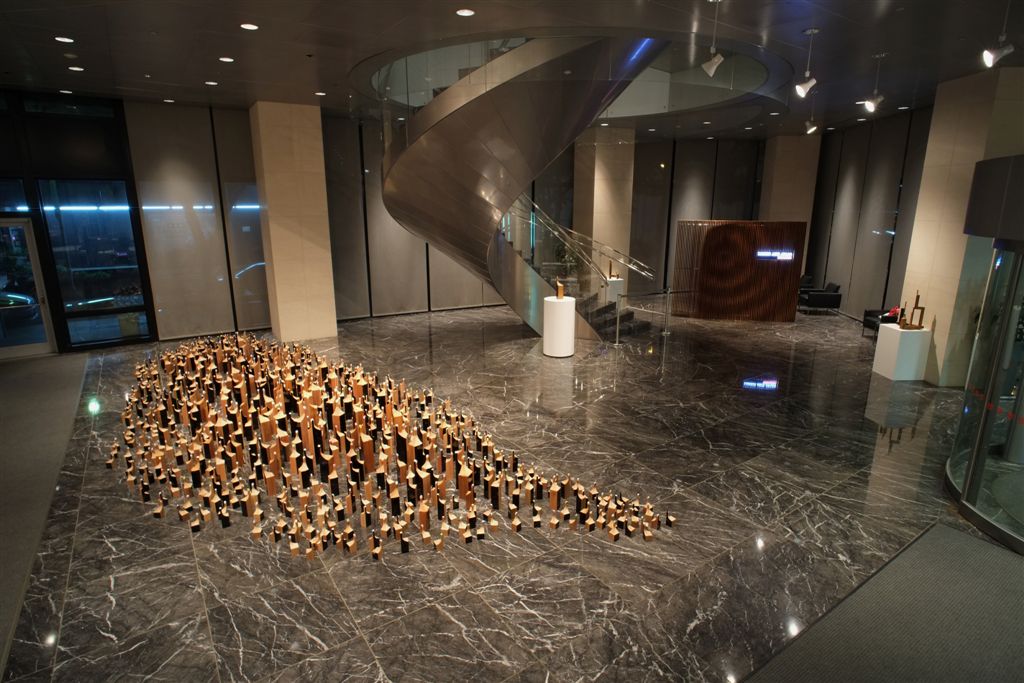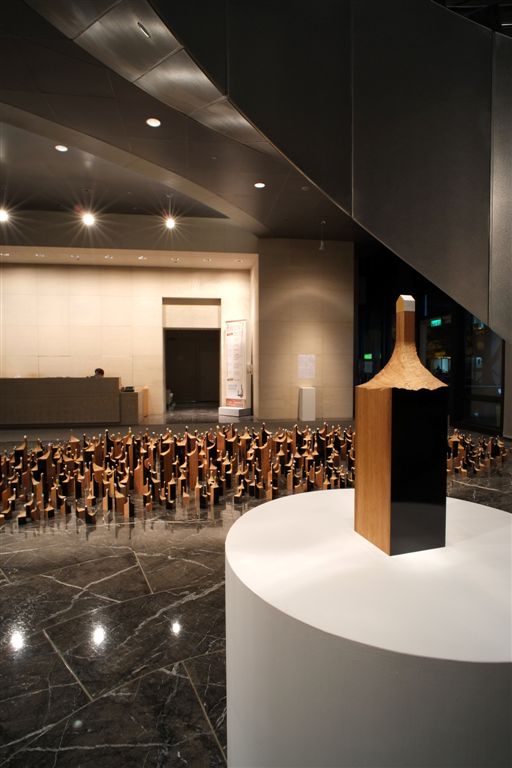
From 2014/05/12 to 2014/06/28
at Taishin Tower 1F
Unluxurious House Plan—Solo Exhibition of TAI Han-Hong
Emerging artist TAI Han-Hong is well-trained in both architecture and design. After he returned from military in 2002, he went to Lukang and Tainan for learning the traditional woodworking craft of the mortise-and-tenon joint. By assembling pieces of wood, he connects tradition with modernity and develops around the concept of “boundaries” in his works. He utilizes wood as creative materials to open up a dialectic discourse of space and time.
After Typhoon Morakot hit Taiwan in 2010, he relocated his studio from southern Taiwan to the suburbs of Taipei and it was downsized from 1800 to 7 square meters. Small as his self-built studio is, it meets all his needs. The small place provides the artist with a stronger sense of space and he calls it an “unluxurious house.”
Upon the invitation of the Taishin Bank Foundation for Arts and Culture, his project of Unluxurious House Plan will be exhibited at the lobby of the Taishin Tower. The exhibition venue is located at the mix-used Eastern District of Taipei, allowing passers-by in and out of the MRT, elevators and air-conditioned high rises to experience the artist’s perspective on space.
About the artist—TAI Han-Hong
Tai graduated from the Department of Industrial Design at Dayeh University and the Graduate Institute of Architecture at the Tainan National University of the Arts. His works have been selected in the 2012 Taipei Arts Award and Made in Taiwan-Young Artist Discovery of the 2012 Art Taipei. His works have been collected by the White Rabbit Gallery of Australia and the National Taiwan Museum of Fine Arts. He currently works and lives in Taipei, Taiwan.

Statement
This began as a single piece of sculpture which gradually developed into a large-scale installation. When the first sculpture was completed, I wrote:
Size of Dwelling is forever in our minds.
The idea of the work came from my small studio which I call my unluxurious house. The unluxurious house references two points: on one hand, as reflections… reactionary thoughts on indulgence and magnificence; on the other, as a metaphor for the lever principle to which Archimedes stated "Give me a place to stand, and I shall move the Earth with it.”
One must look at limitations from a positive perspective. If simplicity, propriety and subtlety are used as objectives then the balance between wants and needs could be readily bridged.
It was from these musings that I conceptualized the: Unluxurious house plan. The idea is to build many small houses on Taiwan's most expensive land. This installation was executed with the help of some volunteers.
The individual pieces were constructed by cutting the wooden beams into thinner dimensions, until I was able to shrink it into smaller houses. To a certain degree, it depicts how my life evolved since five years ago: from a village south of Taiwan to Taipei… from a huge working and living space, rapidly reduced into a small one. More importantly, it represents my realization that living a resplendent life does not require that much space. The challenge is how to manage what is on hand and be gratified with its usage.
From south to north Taiwan, I encountered various issues concerning space limitations. I wish that the spirit and concept evoked in this plan can be an actuality for Taiwan. In this way, we can make full use of what we have (however bountiful or meager the resources may be) and in the process profoundly experience life’s essence.
To build unluxurious houses in well-appointed areas should be viewed as a paradigm shift and an aspirational notion.
I would like to dedicate this work to those who have the means, networks and skills to make better use of what you have and be of service to others. For those who are already on this direction, I am grateful… please continue on this path less travelled.
I would like to extend my deepest thanks for the assistance and participation in this exhibition to:
Wang Te-Yu, Yuan Goang-Ming, Wu Chi-Tsung, Chen Chun-Hao, Huang Yu-Jin, Chen Wei-feng, Ho Chung-Chang, Marika Constantino, Lee Yu Hsuan, Chou Huei Hung, Lu Chi Hsuan, Chiu Yi Hsuan, Yang Chieh Huai, Lin Yong Ci, Hsu Chu Chun, Li Yu wen, Hsueh Yuan Hao, Chien Chih Chung, Weng Yu Ju , Liu Wen Chi, Wu Ting Chia, Tung Yi Ching, Juan Hsin Tzu, Wei-lun Chen, Duan Li Tsen, Lu Chia Chin, Shan Jen Chieh, Hong Wei Chun, Hsu Chih Yang, Tseng Yen Tzu, Chang Tze Hsuan, Taishin Bank Foundation for Arts and Culture, Kuandu Museum of Fine Arts.
Wood
Friends would often ask what kind of wood I make use of; there has always been a curiosity in the type of wood in my works. Unfortunately, if you are expecting some valuable timber species, you will be disappointed. I utilize what I can get in the wood shop, what is readily available for civilians and what is usually used to make wooden furniture. These are imported timber that are of mixed origins. I specifically indicate the medium of my works as "wood" to emphasize its material nature rather than how it is regarded. The materiality of the medium to uphold the artistic value assigned to it is more than adequate.
Indeed, Taiwan's well-known timber is one of the best materials in the world. However, despite the government’s ban on logging, a lot of people still use the country’s wood supplies in order to represent Taiwan. It does not matter if this is acquired illegally or at highly prohibitive costs. Since there are still no definitive measures to perpetuate our forests, coupled with the fact that we are a small island, we may run out of these valuable assets soon, most especially if we are not vigilant. Therefore, Taiwan’s “spirit” should not be denoted through Taiwan’s wood… Taiwan’s real “spirit” should be characterized through reconstituting and skillfully utilizing the given resources (even if these are all importations).
Without a doubt, I favor Taiwan's timber. However, it is more symbolic for me now. I would like to see it thriving and growing in our forests but not in my works. While I may still have some opportunity to acquire and use such precious wood by getting them as gifts from friends or by dismantling some old furniture, windows and doors, the use of particular species is not of utmost importance for my process or concepts. If there comes a point when I do make use of a special variety of timber, a discourse on its perceived value would certainly be part of the conceptualization.

